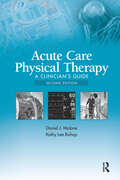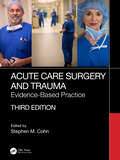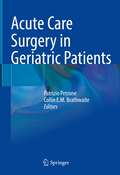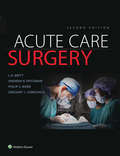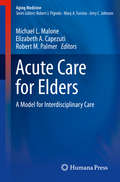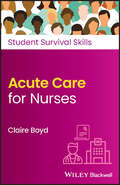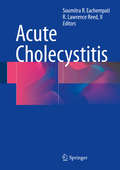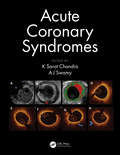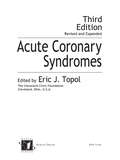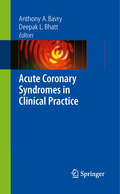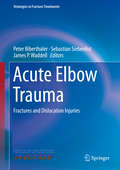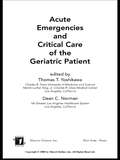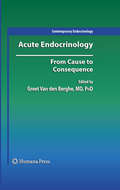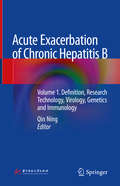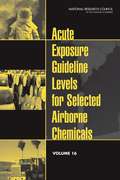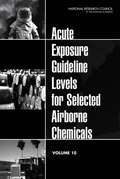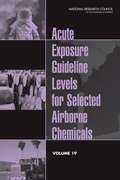- Table View
- List View
Acute Care Physical Therapy: A Clinician’s Guide
by Daniel J. Malone Kathy Lee BishopAcutely ill patients are found in the hospital, in the skilled nursing facility, in inpatient rehabilitation facilities, in outpatient practices, and in the home. The role of the physical therapist and physical therapist assistant is to rehabilitate these vulnerable and frail patients to enhance their health and functioning. The goal of Acute Care Physical Therapy: A Clinician’s Guide, Second Edition is to provide the acute care practitioner with the necessary knowledge to improve patients’ structural impairments and activity limitations so they can more successfully participate in life. Nothing could be more challenging and rewarding. Inside, Drs. Daniel Malone and Kathy Lee Bishop, along with their contributors, provide a comprehensive review of acute care physical therapist best practice. This text builds upon fundamental knowledge by addressing important components of the patient examination ranging from the patient’s medical history to laboratory testing to life supporting equipment. Following this introduction, each chapter highlights specific organ systems with a review of pertinent anatomy and physiology followed by common health conditions and medical management. Important physical therapy concerns, examination findings, and rehabilitation interventions are discussed in detail. This Second Edition includes numerous tables, figures, review questions, and case studies that highlight clinical reasoning and the physical therapy patient care model as outlined in the Guide to Physical Therapist Practice. New in the Second Edition: Increased focus on evidence-based examination, evaluation, and intervention The latest technology in physiologic monitoring and patient support equipment Introduces the “PT Examination” and “ICU” algorithms to promote safe and progressive rehabilitation Emphasis on clinical decision making through the application of a clinical reasoning model applied to the end of chapter cases Acute Care Physical Therapy: A Clinician’s Guide, Second Edition will serve as a valuable education tool for students, newer professionals as well as post-professionals who provide therapy services to the acutely ill patient regardless of setting.
Acute Care Surgery Handbook: Volume 1 General Aspects, Non-gastrointestinal and Critical Care Emergencies
by Fausto Catena Luca Ansaloni Salomone Di Saverio Federico Coccolini George VelmahosThis pocket manual is a practically oriented, wide-ranging guide to acute care surgery general aspects and to non-gastrointestinal emergencies. It covers the most common problems in thoracic, obstetric, gynecologic, anorectal, vascular and skin surgery and also includes chapters on postoperative complications in bariatric surgery, antibiotic management, nutrition and interventional radiology in acute care surgery. This guide stems from collaboration with the World Society of Emergency Surgery (WSES) and aims to provide general surgeons, residents and trainees with a comprehensive and up-to-date overview of the most relevant operative techniques and with useful "tips and tricks" applicable in daily clinical practice. A second volume on gastrointestinal and abdominal surgical emergencies is also available.
Acute Care Surgery Handbook: Volume 2 Common Gastrointestinal and Abdominal Emergencies
by Fausto Catena Luca Ansaloni Salomone Di Saverio Federico Coccolini George VelmahosThis pocket manual is a practically oriented guide to abdominal and gastrointestinal emergencies in acute care surgery. It covers the most common injuries to the entire area, offering careful descriptions of diagnostic procedures, surgical techniques and non-operative management. The guide stems from collaboration with the World Society of Emergency Surgery (WSES) and aims to provide general surgeons, residents and trainees with a comprehensive and up-to-date overview of the most relevant operative techniques and with useful "tips and tricks" applicable in for their daily clinical practice. A second volume on other surgical emergencies, which also includes chapters on antibiotic management, nutrition and interventional radiology in acute care surgery, is also available.
Acute Care Surgery and Trauma: Evidence-Based Practice
by Stephen M. Cohn"Remember, the critical questions in the field of Surgery never change, just the answers!" J. Bradley Aust M.D. 1926-2010 Acute Care Surgery and Trauma: Evidence-Based Practice discusses important surgical management approaches and clinical decision-making based on scientific evidence found in the published literature.Updated and fully revised, this new edition continues to support clinicians by providing the most up-to-date information and evidence on which to base their decisions across a wide range of topics in acute care surgery and trauma, thus optimizing the decision-making process for the care of individual patients. What can be better for the busy clinician than having all the answers to complex questions extensively researched by experts in the field and readily available without requiring further intensive literature searches? Featuring chapters written by specialists in acute care, trauma, and emergency surgery, with extensive references throughout. The text features tables summarizing key evidence and clinical recommendations for quick reference and easy interpretation. It provides an invaluable resource for all acute care surgery and trauma practitioners. "… should be in the library of every medical school, every department of surgery, and every surgeon." " A "must have" resource for every surgeon who manages trauma and acute care surgery patients…particularly useful for surgical residents and Surgical Critical Care and Trauma fellows, and attending surgeons."
Acute Care Surgery in Geriatric Patients
by Patrizio Petrone Collin E. M. BrathwaiteThis comprehensive text will provide a state-of-the art review of the field of geriatric acute care surgery, reviewing new epidemiology data about risk factors for this type of trauma. Assessment of the geriatric trauma patient is unique, and this population requires special attention. Moreover, geriatric patients often suffer from mild to severe cognitive impairment, cardiovascular, and pulmonary insufficiency, which can complicate trauma. This comorbidity informs the evaluation, diagnosis and management of geriatric trauma and stresses the importance of team-based interprofessional care for affected patients. Opening chapters describe general principles of geriatric acute care, the physiology of aging, frailty, injury prevention, and goals of care. The main section of the book presents the latest treatment strategies for traumatic orthopedic, cardiovascular and gastrointestinal trauma, including sepsis, complications and critical care monitoring, before turning to nursing considerations for this ever-growing population. Additional chapters on outcomes and COVID management complete the presentation. Providing a concise yet comprehensive summary of the current status of the field that will help guide patient management and stimulate investigative efforts, this text will serve as a very useful resource for physicians, medical students, residents, nurses, therapists, and researchers dealing with, and interested in this challenging type of trauma.
Acute Care Surgery: Principles And Practice (Spiral Manual Ser.)
by Andrew B. Peitzman L. D. Britt Philip S. Barie Gregory JurkovichPublisher's Note: Products purchased from 3rd Party sellers are not guaranteed by the Publisher for quality, authenticity, or access to any online entitlements included with the product. Substantially updated with more illustrations and brand-new chapters that reflect the growth and advances in the field, this latest edition of Acute Care Surgery features an editorial board drawn from the ranks of trauma surgery, emergency surgery, and critical care surgery. A comprehensive, updated, and timely overview of this fledgling specialty!
Acute Care and Emergency Gynecology
by David Chelmow Christine R. Isaacs Ashley Carroll David Chelmow Christine R. IsaacsAcute Care and Emergency Gynecology covers almost 100 common and uncommon gynecologic problems encountered in urgent and emergency settings. Problems are presented in a case-based approach, integrating relevant evidence-based major Society recommendations where available, and supplementing with carefully researched expert opinion for many common situations for which no guidelines apply. The emphasis in on management. Discussions are designed to be detailed enough to guide practice, but focused to where they can be read in the time available prior to seeing a patient. The book serves two goals: first, it is designed for the many providers who prefer case-based learning, particularly for continuing professional development purposes; secondly, it is designed for rapid reference for someone seeing a similar case in this setting. Essential reading for physicians, midwives, nurse practitioners, and physician assistants in the areas of gynecology, family medicine, and primary care who provide gynecologic care in the urgent and emergency setting.
Acute Care for Elders: A Model for Interdisciplinary Care (Aging Medicine)
by Michael L. Malone Elizabeth A. Capezuti Robert M. PalmerAcute Care for Elders (ACE) is a model of care designed to improve functional outcomes and to improve the processes for the care of older patients. This model includes: an environment of care designed to promote improved function for older patients; an interdisciplinary team that works together to identify/address the vulnerabilities of the older patients; nursing care plans for prevention of disability; early planning to help prepare the patient to return home and a review of medical care to prevent iatrogenic illness. Acute Care for Elders: A Model for Interdisciplinary Care is an essential new resource aimed at assisting providers in developing and sustaining an ACE program The interdisciplinary approach provides an introduction to the key vulnerabilities of older adults and defines the lessons learned from the Acute Care for Elders model Expertly written chapters describe critical aspects of ACE: the interdisciplinary approach and the focus on function The fundamental principles of ACE described in this book will further assist hospital leaders to develop, implement, sustain and disseminate the Acute Care for Elders model of care. Acute Care for Elders: A Model for Interdisciplinary Care is of great value to geriatricians, hospitalists, advance practice nurses, social workers and all others who provide high quality care to older patients.
Acute Care for Nurses (Student Survival Skills)
by Claire BoydAcute Care for Nurses A practical handbook to boost your confidence with assessment techniques and key clinical skills when administering effective acute care This helpful revision tool was developed to assist healthcare workers in the field of acute care, at a time when healthcare professionals have been under more pressure than ever before. In Acute Care for Nurses, readers will find: A revision of medicines management formulas, plus advanced formulas seen in a clinical setting, with chapters on sepsis and conflict resolution Assessment techniques and the individual components of the ABCDE assessment, covering vital signs, clinical observation at superficial and more in-depth levels, and clinical actions Higher skills, such as caring for the ventilated patient and fluid resuscitation in adults and children, and subcutaneous fluid hydration Critical care simulation and need-to-know medical abbreviations, plus three helpful appendices containing tool kits and charts Acute Care for Nurses is a must-have resource for nursing students, including nursing associates, registered nurses and midwives, assistant practitioners and senior healthcare assistants, return to practice nurses, overseas nurses and anyone else requiring acute clinical skills and assessment techniques.
Acute Care of the Cancer Patient
by Thomas W. Feeley Allen W. Burton Bernhard J. Riedel Andrew D. Shaw Alan I. FieldsDrawing on the real-world experience of leading experts in oncological medicine, this reference serves as an invaluable source of guidance for anyone specializing in the care of acutely ill cancer patients-providing quick reference to effective techniques, therapies, and approaches for surgical, medical, pediatric, pain, and general oncology issues
Acute Cholecystitis
by Soumitra R. Eachempati R. Lawrence ReedThis text covers all aspects of the current diagnosis and treatment of acute cholecystitis. Different diagnostic tests are discussed as well as the preoperative evaluation needed to initiate treatment. Other sections include the management of acute cholecystitis in the critically ill and elderly patients, recent advances in operative strategies that have further altered the treatment of acute cholecystitis, and the utilization of routine intraoperative cholangiography and its relative merits. Primarily intended for general surgeons and residents training in general surgery, Acute Cholecystitis will also serve as a comprehensive reference material for other health care providers, including primary care providers, mid-level nurse practitioners, emergency room physicians and medical students.
Acute Coronary Syndromes
by K Sarat Chandra Aj SwamyAcute Coronary Syndrome (ACS) is a growing global menace with patients increasing in developing countries where tobacco and food play a major role. Its treatment guidelines and research results have proliferated in academia, but practical applications lag behind that research. This book addresses this void. Guidelines for treatment of ACS present in-depth reading for practicing cardiologists, thus preventing clinical application. The book aims to appraise readers of real-world situations and suggestions to help them acquire up-to-date knowledge on ACS and its effective diagnosis, prognosis and management. Key Features Covers recent advances in ACS management and pharmacotherapy Discusses the guidelines for treatment of ACS for the professional cardiologist to apply to clinical practice Explores the topics with the help of case scenarios Follows a concise, yet comprehensive approach Features a chapter on 'When to Transfer,' which discusses how to spot unstable patients or those heading towards shock
Acute Coronary Syndromes (Contemporary Cardiology Ser.)
by Eric J. TopolWith detailed contributions from 45 renowned international authorities, this Third Edition stands alone as the most comprehensive, contemporary view of the biology, physiology, and management of acute coronary syndromes (ACS)-offering 32 chapters that span the state-of-the science in the field and provide intriguing discussions on CRP and other dis
Acute Coronary Syndromes in Clinical Practice
by Deepak L. Bhatt Anthony A BavryThis practical book provides a comprehensive overview of the epidemiology and clinical presentation of acute coronary syndromes (ACS). It also guides the reader through risk assessment, risk stratification, diagnosis, and treatment of ACS.
Acute Elbow Trauma: Fractures And Dislocation Injuries (Strategies in Fracture Treatments)
by Peter Biberthaler James P. Waddell Sebastian SiebenlistThis volume focuses on acute trauma to the adult elbow, including fractures, dislocations, tendon ruptures, and vascular and nerve injuries. Each chapter addresses anatomical key features, surgical and conservative therapeutic procedures, postoperative regimes and complication strategies. International elbow experts explore a range of surgical approaches, the usage of modern implants, advances in surgical techniques, and pearls and pitfalls for each trauma entity. Moreover, the authors describe total elbow arthroplasty and radial head replacement in detail, outline current clinical outcomes, and provide recommendations for therapeutic approaches and salvage measures. The book enables the orthopedic surgeon to deal with the entire spectrum of acute simple and complex elbow injuries in adults.
Acute Emergencies and Critical Care of the Geriatric Patient
by Thomas T. Yoshikawa Dean C. NormanThis incisive reference systematically reviews the diagnosis and treatment of common surgical and medical emergencies in elderly patients-thoroughly examining surgical interventions, drug therapies and drug prescribing protocols, life-threatening drug reactions, ethical issues, and methods of profiling patients for nursing care. Evaluates disea
Acute Endocrinology: From Cause to Consequence (Contemporary Endocrinology)
by Greet Van den BergheThe integration of endocrinology in critical care medicine has led to new experimental and clinical data on the complex endocrine and metabolic derangements accompanying non-endocrine severe illnesses. The joining of these two disciplines has generated important novel insights with significant clinical implications. Acute Endocrinology: From Cause to Consequence compiles these new findings into an important and highly relevant new resource. Part one deals with the classical life-threatening illnesses caused by primary endocrine diseases such as thyrotoxicosis, hypothyroidism, acute adrenal crisis, acute calcium disorders, pheochromocytoma, severe hyper- and hypoglycemia. Part two looks at endocrinology from the ICU side, starting with a general overview of the dynamic neuroendocrine and metabolic stress responses in the condition of intensive care-dependent, non-endocrine critical illness. Acute Endocrinology: From Cause to Consequence provides a unique and up-to-date overview of the joining of these two disciplines and seeks to stimulate further interdisciplinary research in this important and exciting field.
Acute Exacerbation of Chronic Hepatitis B: Volume 1. Definition, Research Technology, Virology, Genetics and Immunology
by Qin NingThis book assembles recent achievements in both basic research and clinical management in the field of hepatology, virology and immunology. It provides up-to-date information for clinicians who can apply the relevant knowledge to their daily clinical practice and for researchers who are interested in clinically orientated studies. The updated and detailed technology, state-of–the-art treatment strategies provided in this book serve as references for clinicians and resident physicians in the daily management of ACLF. The rationality and strategies for basic research as well as patient management in this book can also be a valuable reference for other fatal and end stage liver diseases than HBV induced ACLF. This volume 1 has 6 chapters and focuses on the definition, research technology, virology, genetics, and immunology.
Acute Exacerbation of Chronic Hepatitis B: Volume 2. Diagnosis and Management
by Qin NingThis book assembles recent achievements in both basic research and clinical management in the field of hepatology, virology and immunology. It provides up-to-date information for clinicians who can apply the relevant knowledge to their daily clinical practice and for researchers who are interested in clinically orientated studies. The updated and detailed technology, state-of–the-art treatment strategies provided in this book serve as references for clinicians and resident physicians in the daily management of ACLF. The rationality and strategies for basic research as well as patient management in this book can also be a valuable reference for other fatal and end stage liver diseases than HBV induced ACLF. This Volume 2 has 6 chapters and focuses on its diagnosis and management.
Acute Exposure Guideline Levels for Selected Airborne Chemicals
by National Research Council Committee on Toxicology Division On Earth Life Studies Committee on Acute Exposure Guideline Levels Board on Environmental Studies ToxicologyAcute Exposure Guideline Levels for Selected Airborne Chemicals, Volume 15 identifies, reviews, and interprets relevant toxicologic and other scientific data for ethyl mercaptan, methyl mercaptan, phenyl mercaptan, tert-octyl mercaptan, lewisite, methyl isothiocyanate, and selected monoisocyanates in order to develop acute exposure guideline levels (AEGLs) for these high-priority, acutely toxic chemicals. AEGLs represent threshold exposure limits (exposure levels below which adverse health effects are not likely to occur) for the general public and are applicable to emergency exposures ranging from 10 minutes (min) to 8 h. Three level--AEGL-1, AEGL-2, and AEGL-3--are developed for each of five exposure periods (10 min, 30 min, 1 h, 4 h, and 8 h) and are distinguished by varying degrees of severity of toxic effects. This report will inform planning, response, and prevention in the community, the workplace, transportation, the military, and the remediation of Superfund sites.
Acute Exposure Guideline Levels for Selected Airborne Chemicals
by Committee on Acute Exposure Guideline LevelsThe Bhopal Disaster of 1984 resulted in the death of around 2,000 residents living near chemical plants and irreversible injuries to more than 20,000 other residents. These numbers can be attributed to the community's lack of awareness concerning the chemicals' existence, dangers and effects, and/or how to react in case of emergency. The disaster emphasized the need for governments to identify hazardous substances and to aid local communities in developing plans for emergency exposures. As a result, the United States government issued the Superfund Amendments and Reauthorization Act (SARA) of 1986; requiring the identification of extremely hazardous substances (EHSs) by the Environmental Protection Agency (EPA). EPA was also tasked with assisting Local Emergency Planning Committees (LEPCs) in conducting health-hazard assessments to develop emergency-response plans for sites where EHSs are produced, stored, transported, or used. The EPA identified nearly 400 EHSs in terms of their immediate danger to life and health (IDLH) as their first step in assisting these LEPCs. In 1991 the EPA went on to request that the National Research Council (NRC) Committee on Toxicology (COT) develop criteria and methods for developing emergency exposure levels for EHSs for the general population. The COT, who had published many reports on emergency exposure guidance levels at the time, designated the task to a subcommittee. The subcommittee focused on Guidelines for Developing Community Emergency Exposure Levels for Hazardous Substances. Four years later the National Advisory Committee for Acute Exposure Guideline Levels for Hazardous Substances (NAC) was created with a focus on identifying, reviewing, and interpreting relevant toxicologic and other scientific data and developing acute exposure guideline levels (AEGLs) for high-priority, acutely toxic chemicals. In Acute Exposure Guideline Levels for Selected Airborne Chemicals: Volume 4, the NAC outlines acute exposure guideline levels for chlorine, hydrogen chloride, toluene 2,4, hydrogen fluoride, 2,6-diisocyanate, and uranium hexafluoride.
Acute Exposure Guideline Levels for Selected Airborne Chemicals
by The National Academy of SciencesExtremely hazardous substances (EHSs)sup2; can be released accidentally as a result of chemical spills, industrial explosions, fires, or accidents involving railroad cars and trucks transporting EHSs. Workers and residents in communities surrounding industrial facilities where EHSs are manufactured, used, or stored and in communities along the nation's railways and highways are potentially at risk of being exposed to airborne EHSs during accidental releases or intentional releases by terrorists. Pursuant to the Superfund Amendments and Reauthorization Act of 1986, the U. S. Environmental Protection Agency (EPA) has identified approximately 400 EHSs on the basis of acute lethality data in rodents. As part of its efforts to develop acute exposure guideline levels for EHSs, EPA and the Agency for Toxic Substances and Disease Registry (ATSDR) in 1991 requested that the National Research Council (NRC) develop guidelines for establishing such levels. In response to that request, the NRC published Guidelines for Developing Community Emergency Exposure Levels for Hazardous Substancesin 1993. Subsequently, Standard Operating Procedures for Developing Acute Exposure Guideline Levels for Hazardous Substanceswas published in 2001, providing updated procedures, methodologies, and other guidelines used by the National Advisory Committee (NAC) on Acute Exposure Guideline Levels for Hazardous Substances and the Committee on Acute Exposure Guideline Levels (AEGLs) in developing the AEGL values. In 1998, EPA and DOD requested that the NRC independently review the AEGLs developed by NAC. In response to that request, the NRC organized within its Committee on Toxicology (COT) the Committee on Acute Exposure Guideline Levels, which prepared this report. Acute Exposure Guideline Levels for Selected Airborne Chemicalsis the tenth volume of the series and documents for N,N-dimethylformamide, jet propellant fuels 5 and 8, methyl ethyl ketone, perchloromethyl mercaptan, phosphorus oxychloride, phosphorus trichloride, and sulfuryl chloride.
Acute Exposure Guideline Levels for Selected Airborne Chemicals: VOLUME 2
by National Research Council of the National AcademiesThis book reviews toxicity documents on five chemicals that can be released in the air from accidents at chemical plants, storage sites, or during transportation. The documents were prepared by the National Advisory Committee on Acute Exposure Guideline Levels for Hazardous Substances and were evaluated for their scientific validity, comprehensives, internal consistency, and conformance to the 1993 guidelines report.
Acute Exposure Guideline Levels for Selected Airborne Chemicals: VOLUME 3
by National Research Council of the National AcademiesThis report is the third volume in the series Acute Exposure Guideline Levels for Selected Airborne Chemicals. <P><P> In the Bhopal disaster of 1984, approximately 2,000 residents living near a chemical plant were killed and 20,000 more suffered irreversible damage to their eyes and lungs following accidental release of Methyl Isocyanate. The toll was particularly high because the community had little idea what chemicals were being used at the plant, how dangerous they might be, and what steps to take in case of emergency. This tragedy served to focus international attention on the need for governments to identify hazardous substances and to assist local communities in planning how to deal with emergency exposures.
Acute Exposure Guideline Levels for Selected Airborne Chemicals: Volume 17
by Committee on Acute Exposure Guideline LevelsExtremely hazardous substances can be released accidentally as a result of chemical spills, industrial explosions, fires, or accidents involving railroad cars and trucks transporting EHSs. Workers and residents in communities surrounding industrial facilities where these substances are manufactured, used, or stored and in communities along the nation's railways and highways are potentially at risk of being exposed to airborne EHSs during accidental releases or intentional releases by terrorists. Pursuant to the Superfund Amendments and Reauthorization Act of 1986, the U. S. Environmental Protection Agency (EPA) has identified approximately 400 EHSs on the basis of acute lethality data in rodents. "Acute Exposure Guideline Levels for Selected Airborne Chemicals, Volume 17" identifies, reviews, and interprets relevant toxicologic and other scientific data for selected AEGL documents for acrylonitrile, carbon tetrachloride, cyanogen, epichlorohydrin, ethylene chlorohydrin, toluene, trimethylacetyl chloride, hydrogen bromide, and boron tribromide in order to develop acute exposure guideline levels (AEGLs) for these high-priority, acutely toxic chemicals. AEGLs represent threshold exposure limits (exposure levels below which adverse health effects are not likely to occur) for the general public and are applicable to emergency exposures ranging from 10 minutes (min) to 8 h. Three levels - AEGL-1, AEGL-2, and AEGL-3 - are developed for each of five exposure periods (10 min, 30 min, 1 h, 4 h, and 8 h) and are distinguished by varying degrees of severity of toxic effects. This report will inform planning, response, and prevention in the community, the workplace, transportation, the military, and the remediation of Superfund sites.
